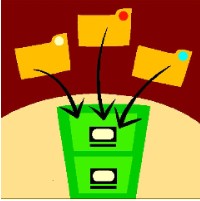
|
Math Activity Themes: Bats
|
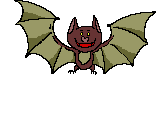
|

Bats are a common theme at Halloween. Use these resources to capitalize on student interest in bats and develop student understanding of common mathematical patterns.
Pascal's Bats
 Pascal's Bats is an effective introduction to Pascal's Triangle. Students must look for patterns in this bat variation of Pascal's Triangle. The activity challenges students to identify patterns, fill in the missing numbers and write the next line in the pattern. Class discussion should encourage students to share all of the patterns they see in Pascal's Triangle and discuss how these patterns helped them discover the missing numbers. Pascal's Bats is an effective introduction to Pascal's Triangle. Students must look for patterns in this bat variation of Pascal's Triangle. The activity challenges students to identify patterns, fill in the missing numbers and write the next line in the pattern. Class discussion should encourage students to share all of the patterns they see in Pascal's Triangle and discuss how these patterns helped them discover the missing numbers.
Bat Cave Bulletin Board
Create a  Bat Cave Bulletin Board to practice basic math facts during the bat unit. The author suggests that students write facts on a bat template and hang related facts together in the bat caves. Bat Cave Bulletin Board to practice basic math facts during the bat unit. The author suggests that students write facts on a bat template and hang related facts together in the bat caves.
|
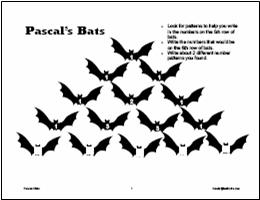
|
These graphing activities deliberately include varied options for graphing the results so that students become familiar with different graph models to replace the very common bar graph.
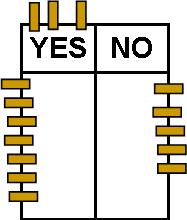
|
- Venn Diagram: After reading the Kathi Appelt book series, students vote on their favorite of the three books. Consider using an overlapping Venn diagram as a different option. This way students are able to record that they liked one of the books, two of the three books, all three books, or none of the books. Ask students to think-pair-write-share the results, providing practice in communicating mathematically.
- Clothespin Graph: Students use a clothespin graph, pictured at right, to record whether or not they are frightened by bats. Follow this discussion with some facts about how bats are good for the environment. For example, GLOBIO's Glossopedia article on Bats uses information and pictures to help students learn more about these often misunderstood mammals. After viewing, have students take an exit poll to see if students have changed their minds once they know more about bats. Analyze the differences between the graphs.b
- Line Plot: Have students take the paper-and-pencil
 Bat IQ Test or the online Bat IQ Test or the online  Bat Quiz to see how much students know about bats. Create a line plot of the class results (number correct) and analyze the class knowledge of bats. As an extension, ask students to predict how they think adults would fare on the bat quiz, then have them give parents the quiz, create a line plot of the class results and compare these results to student results. Is there a difference? Why or why not? Bat Quiz to see how much students know about bats. Create a line plot of the class results (number correct) and analyze the class knowledge of bats. As an extension, ask students to predict how they think adults would fare on the bat quiz, then have them give parents the quiz, create a line plot of the class results and compare these results to student results. Is there a difference? Why or why not?
|
There Was an Old Lady Who Swallowed a Bat by Lucille Colandro
- After reading the book, investigate
 Batty Old Lady Probability, Students spin to collect all of the items the Batty Old Lady swallowed, and tally each spin on the recording sheet. They then calculate the total spins it took them to get all 7 items, and add that figure to the class data. Teachers may help students analyze the class data and learn about probability in the process. The pdf document includes directions, game mat, picture cards, spinner, recording sheet and writing to learn handout. Batty Old Lady Probability, Students spin to collect all of the items the Batty Old Lady swallowed, and tally each spin on the recording sheet. They then calculate the total spins it took them to get all 7 items, and add that figure to the class data. Teachers may help students analyze the class data and learn about probability in the process. The pdf document includes directions, game mat, picture cards, spinner, recording sheet and writing to learn handout.
- Download
 Old Lady template to use in retelling the story Old Lady template to use in retelling the story
- After reading, enjoy the original There Was an Old Lady Who Swallowed a Fly book, enjoy the
 Old Lady and Probability lessons. Old Lady and Probability lessons.
- Use the
 Old Lady reproducible for students to design their own versions of the story. Old Lady reproducible for students to design their own versions of the story.
- Use Scholastic's
 Edible Estimation suggestion to incorporate measurement into this book talk. Scroll down the Scholastic page to locate this section. Edible Estimation suggestion to incorporate measurement into this book talk. Scroll down the Scholastic page to locate this section.
|
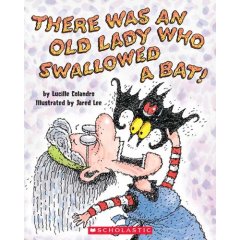
|
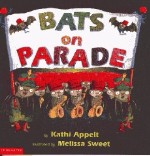
|
Bats on Parade by Kathi Appelt
This book is a literary introduction to square numbers and the patterns they form as square arrays. The bats march in parade formation and different sections of the band, being different sizes, march in different arrays: "In nine rows of nine those trombones reported, while there, right behind them, the tubas retorted." The pictures and rhyme reinforce the mathematics of the patterns and teachers can easily ask students to predict how many bats will be in the next section or ask them to figure out how many bats are in the whole band before reading those pages. Add this book to your collection of problem-solving literature prompts.
- Multiplication Arrays: The book is a great introduction to multiplication arrays. Use the book illustrations to show students how to use an array to model a multiplication problem then ask students to create arrays for different multiplication facts.
- See examples of
 Student Multiplication Arrays created by a third grade class. Student Multiplication Arrays created by a third grade class.
- Class on Parade Book: Challenge students to design an array and a rhyme for an original page in the Class on Parade book. Decide on a theme and let pairs of students work on both the math and the language for a page.
|
Bat Jamboree by Kathi Appelt
Bat Jamboree introduces the triangular number pattern as bats assemble for the final number beginning with 10 bats in the bottom row, 9 in the next row, etc. to the very top row with 1 bat. Students are introduced to the 55 bats in formation and their various acts but the book "isn't over until the bat lady sings." Students will enjoy this introduction to an important mathematical pattern. Teachers can find many problems that build upon this triangular number pattern and extend the experience.
- Student Written Problems: ask students to write original problems that use the triangular number pattern. Being able to write similar problems and solve them require higher-order thinking skills as students apply, synthesize and evaluate both the problems and the solutions.
|
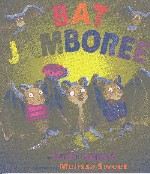
|
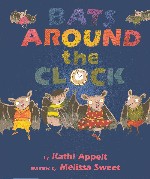
|
Bats Around the Clock by Kathi Appelt
Take a humorous dance through time. Click Dark and American Batstand introduce a new dance each hour. Students move through time, enjoy some rhyme and learn the names of some oldie-but-goodie dances along the way.
- Making Time: For the second reading, give students individual clocks and ask them to move the hour hand to the next hour and say the time before reading the book section for that hour.
- School Time: Provide copies of the
 School Time Template and have students choose a time in the school day, draw the hands on the clock, write a verse and draw an illustration that shows what the class does during that hour. Assemble the individual hours into a class booklet or booklets, depending on the number of students in the class. This activity is easily differentiated to feature time on the hour, or to use the real time schedule of activity changes the class follows. The template clock deliberately shows no hands, allowing teachers to customize the activity to the appropriate mathematical level of students in the class. School Time Template and have students choose a time in the school day, draw the hands on the clock, write a verse and draw an illustration that shows what the class does during that hour. Assemble the individual hours into a class booklet or booklets, depending on the number of students in the class. This activity is easily differentiated to feature time on the hour, or to use the real time schedule of activity changes the class follows. The template clock deliberately shows no hands, allowing teachers to customize the activity to the appropriate mathematical level of students in the class.
|
Fat Bat Game
Students roll a die to see how many insects their bat eats. Students may continue rolling, in this Bat version of Pig, until they elect to stop, or until they roll a 1. But be careful! If your bat is still eating (collecting points) when a one is tossed, you are a Fat Bat and lose all of your points for that round.
This game is designed to provide a fun experience in the experimental probability of a single die toss. However, students get lots of practice adding a string of single digit numbers, as they total up their winning points for each round. A data analysis option is included to formally extend the analysis of the game's probability for older students.
Download  Fat Bat for the student recording sheet, directions for whole class play, and data analysis option for extending the game. Fat Bat for the student recording sheet, directions for whole class play, and data analysis option for extending the game.
|
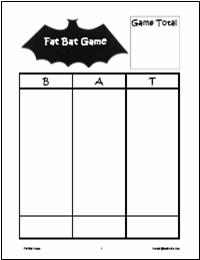
|
Bat Problem Solving

|
-
 Night Bat challenges students to identify the pattern found in the number of insects the bat eats during the night feeding hours and use that pattern to find the total number of insects eaten during the night. Night Bat challenges students to identify the pattern found in the number of insects the bat eats during the night feeding hours and use that pattern to find the total number of insects eaten during the night.
-
 Flying Bats also challenges students to identify the pattern found in the bats' formation as they fly back to the cave after feeding. Students must use that pattern to find the total number of bats flying in the formation. Flying Bats also challenges students to identify the pattern found in the bats' formation as they fly back to the cave after feeding. Students must use that pattern to find the total number of bats flying in the formation.
- See The Math Forum's
 The Four Doors of Xanth for a logic problem that involves bats. A step-by-step solution is also provided in this Ask Dr. Math selection. The Four Doors of Xanth for a logic problem that involves bats. A step-by-step solution is also provided in this Ask Dr. Math selection.
|
Bat Links
-
 Bat Math Quiz incorporates bat facts with problem solving for older math students. Bat Math Quiz incorporates bat facts with problem solving for older math students.
- Bat Symmetry: Have students create a
 Bat mask, using the pattern provided and fold to examine the symmetry of the design. Or adapt this craft for older students to emphasize the symmetry of the bat design. Create a "half-pattern" for the bat. Students should fold a piece of black construction paper, trace the half-bat, then cut it folded. Unfolding the cut design creates a full, symmetrical bat. Decorate with symmetrical eyes, etc. Bat mask, using the pattern provided and fold to examine the symmetry of the design. Or adapt this craft for older students to emphasize the symmetry of the bat design. Create a "half-pattern" for the bat. Students should fold a piece of black construction paper, trace the half-bat, then cut it folded. Unfolding the cut design creates a full, symmetrical bat. Decorate with symmetrical eyes, etc.
- Visit the
 Bat Math Project for more data on different species of bats. Students can use the data to write their own bat word problems. Bat Math Project for more data on different species of bats. Students can use the data to write their own bat word problems.
- GLOBIO's Glossopedia article on Bats uses information and pictures to help students learn more about these often misunderstood mammals. This might be an effective follow-up to the bat quiz.
- The
 Batty about Bats unit of study followed a real-life experience with bats. Batty about Bats unit of study followed a real-life experience with bats.
- The
 Bats Pre Visit Packet contains a Bat Quiz, a page of bat math problems, a picture to color, and other bat activities. Bats Pre Visit Packet contains a Bat Quiz, a page of bat math problems, a picture to color, and other bat activities.
|
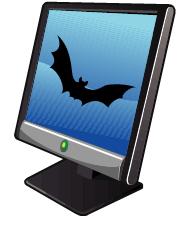
|














